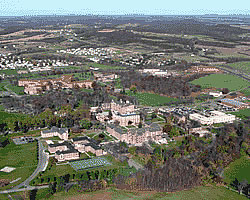About EMI

CAMPUS AND FACILITIES
The National Emergency Training Center (NETC) in Emmitsburg, Maryland, is the home of the Emergency Management Institute (EMI) and offers the finest in educational resources. The 107 acre campus also houses the U.S. Fire Administration and the National Fire Academy. The campus is located 12 miles south of Gettysburg, Pennsylvania; 75 miles north of the District of Columbia; and 50 miles northwest of Baltimore, Maryland.
The campus is fully equipped with air-conditioned classrooms, lodging for participants, a library, and dining and recreational facilities. There are also several specialized facilities, such as the simulation and exercise laboratory, a television studio, and four computer laboratories that are integral to the instruction of many courses.
EMERGENCY MANAGEMENT INSTITUTE
The mission of the Emergency Management Institute (EMI) is to “Support the Department of Homeland Security and the Federal Emergency Management Agency’s (FEMA’s) goals by improving the competencies of U.S. officials at all levels of Government to prevent, prepare for, respond to, recover from, and mitigate the potential effects of all types of disasters and emergencies on the American people.”
Located on the campus of the National Emergency Training Center (NETC) in Emmitsburg, Maryland, EMI is the emergency management community’s flagship training institution. EMI provides training to Federal, state, local, tribal, volunteer, public, and private sector officials to strengthen emergency management core competencies for professional, career-long training. EMI trains more than two million students annually.
Instruction incorporates the principles of emergency management through instructional systems design in order to create a framework for the whole community to reduce vulnerability to hazards and to cope with disasters. EMI develops courses and implements training delivery systems to include residential onsite training; offsite delivery in partnership with emergency management training systems, colleges, and universities; and technology-based mediums to conduct individual training courses for emergency management and response personnel across the Nation.
NETC Library
The NETC Library is home to one of the nation’s preeminent collections of all-hazards first responder resources. The library supports research in emergency management, fire, and emergency medical services. Topics covered run the gamut of natural and manmade hazards from fires and hurricanes to tornadoes and flooding, from chemical and biological to radiological and nuclear hazards.
Library services include phone and email reference, catalog searching, and research assistance. NETC students can schedule virtual research consultations, use library databases and eBooks, and check out materials when on campus.
The library is open to NETC staff, instructors, and students, as well as the public by appointment. Members of the public must call at least 24 hours in advance at (301) 447-1030. Public visitor access will not be granted after 5 p.m. (Monday–Thursday) or on the weekend unless prior arrangements have been made.
When classes are in session, the library’s regular schedule of hours is Monday through Thursday, 8:30 a.m. to 9 p.m., and Friday, 12 p.m. to 4 p.m. The library is open some weekends when students are on campus. Hours are posted on the library website.
Visit the library web site at https://www.usfa.fema.gov/library/ to search the extensive collection.
Contact the library at:
National Emergency Training Center Library
16825 South Seton Avenue
Emmitsburg, Maryland 21727
(301) 447-1030
[email protected]
The National Civil Defense/Emergency Management Monument
On November 13, 1999, President Clinton signed a bill (HR 348/PL 106 103) that granted authority to the National Civil Defense Monument Commission to construct a monument at FEMA’s NETC in Emmitsburg, Maryland.
The purpose of the monument is to honor the thousands of civil defense and emergency management professionals and volunteers who have worked hard and faithfully to protect the public from both manmade and natural hazards. This monument particularly recognizes the numerous military and civilian volunteers and professionals who have gone beyond the normal call of duty to save lives and alleviate suffering in times of crises. The monument serves as an enduring reminder of the heartfelt thanks that a multitude of people feel whenever they remember those who have selflessly served them, or their loved ones, in times of great need.
The centerpiece of the monument is a 15 ton block of polished white Vermont granite, shaped as a three-sided pyramid, representative of the Federal, state, and local governments and their efforts in working together to accomplish a joint mission. The triangular base is 5 feet on each side, rising to 15 feet in height. The pinnacle of the monument is capped with a large, bronze American eagle, sculpted by the world-renowned sculptor, Lorenzo Ghiglieri. The base is encircled by a stone and concrete plaza with appropriately inscribed bronze state plaques embedded in concrete, surrounded by a circle of state flags. A brick wall rises approximately 3 feet in height on the back or south side of the plaza. Near the edge of the plaza are two bronze plaques bearing the names of advocates and members of the Monument Commission.
The monument was dedicated on April 6, 2002. The Commission plans to hold an annual memorial service to pay tribute to those who have given to their fellow citizens by mitigating the potential losses from emergency situations, for those who have responded to emergencies, and to the professionals and our elected officials who strive to improve the methods of handling emergencies.